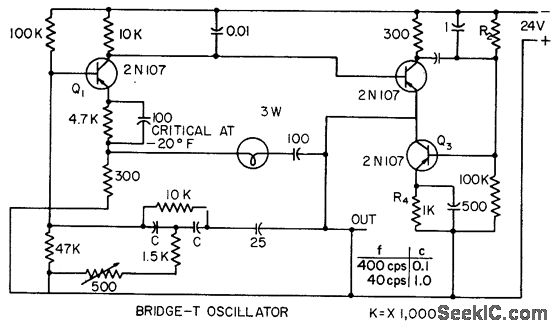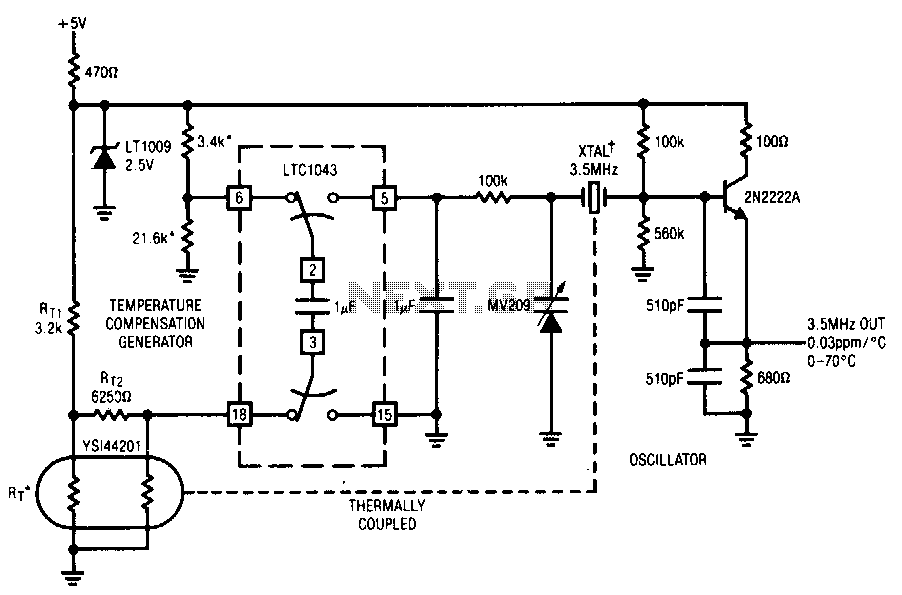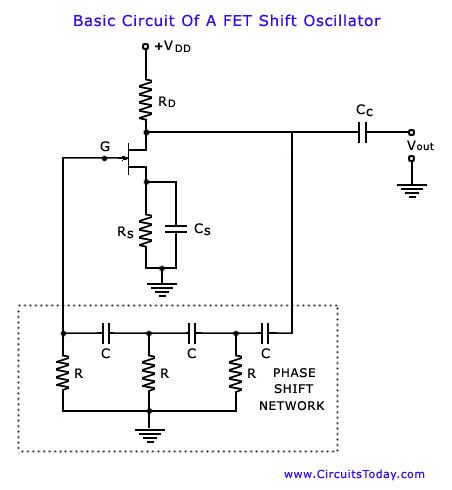
BRIDGED T AUDIO OSCILLATOR

This circuit incorporates heavy degenerative feedback, utilizing a small lamp as a nonlinear compensating resistance. It provides a constant output frequency and voltage for supply voltages ranging from 12 to 32 V, and operates effectively at temperatures as low as -20 °F. The output frequency is determined by capacitors C and a 500-ohm trimmer control, allowing for frequency selection at 100, 150, 230, and 350 cycles per second.
The described circuit employs a robust feedback mechanism that enhances stability and linearity in its operation. The use of a small lamp as a nonlinear compensating resistance plays a crucial role in maintaining consistent performance across varying supply voltages and ambient temperatures. This design is particularly advantageous for applications requiring reliable frequency generation in harsh environmental conditions.
The frequency selection is achieved through the integration of capacitors and a trimmer potentiometer, which allows for precise adjustments. The capacitors (denoted as C) are selected based on the desired frequency output, with the trimmer providing fine-tuning capabilities. This flexibility is essential for applications that may require different operational frequencies, such as in glacial trail detection systems.
In summary, the circuit's design is optimized for a wide range of supply voltages and environmental conditions, making it suitable for specialized applications in electronics where consistent frequency and voltage output are critical. The combination of heavy degenerative feedback and nonlinear compensation ensures that the circuit remains stable and functional under varying conditions, thereby enhancing its reliability and performance in practical use cases.Incorporates heavy degenerative feedback in which small lamp is nonlinear compensating resistance. Provides constant output frequency and voltage for any supply between 12 and 32 V, at temperatures down to -20 °F. Frequency is determined by capacitors C and 500-ohm trimmer control, to give choice of 100, 150, 230, and 350 cps.
-H. P. Van Eckhardt, Crevasse Detector Blazes Glacial Trails, Electronics, 31:3, p 63-65. 🔗 External reference
The described circuit employs a robust feedback mechanism that enhances stability and linearity in its operation. The use of a small lamp as a nonlinear compensating resistance plays a crucial role in maintaining consistent performance across varying supply voltages and ambient temperatures. This design is particularly advantageous for applications requiring reliable frequency generation in harsh environmental conditions.
The frequency selection is achieved through the integration of capacitors and a trimmer potentiometer, which allows for precise adjustments. The capacitors (denoted as C) are selected based on the desired frequency output, with the trimmer providing fine-tuning capabilities. This flexibility is essential for applications that may require different operational frequencies, such as in glacial trail detection systems.
In summary, the circuit's design is optimized for a wide range of supply voltages and environmental conditions, making it suitable for specialized applications in electronics where consistent frequency and voltage output are critical. The combination of heavy degenerative feedback and nonlinear compensation ensures that the circuit remains stable and functional under varying conditions, thereby enhancing its reliability and performance in practical use cases.Incorporates heavy degenerative feedback in which small lamp is nonlinear compensating resistance. Provides constant output frequency and voltage for any supply between 12 and 32 V, at temperatures down to -20 °F. Frequency is determined by capacitors C and 500-ohm trimmer control, to give choice of 100, 150, 230, and 350 cps.
-H. P. Van Eckhardt, Crevasse Detector Blazes Glacial Trails, Electronics, 31:3, p 63-65. 🔗 External reference





